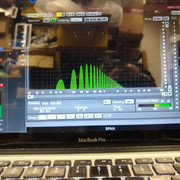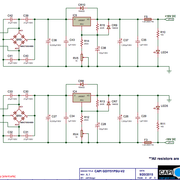Aleguitarpro
Well-known member
Hi
Just finished a 16 channel summing mixer made with NE5532/5534 input stage, an additional active "gain" stage for saturation, very easy summing section etc etc.
The summing mixer works perfectly.
Global power consumption is about 800 mA per rail (+16/-16).
I have this problem: when I engage all the 16 additional gain stages on each channel this noise (ripple?) passed trough audio line.

At the beginning of the building I used 317/337 for PSU with big filtering caps (10.000uF on each rail).
Now I tried to use this power supply (it's super oversized for this project):

and the problem starts random after 14 of 16 additional gain stage on.
But this additional gain stage is always powered, it's only "audio" bypassed.
Any idea?
I never had this kind of noise before but it's for sure related to power supply.
The mysterious part of the problem is that sometimes disappear with all the additional gain on.
Sometimes appear with 12 of 16 channels gain "on".
I think is related to ripple but I tried to work on filtering and at the beginning it helps.
Now I'm at 4700uF+4700uF+3300uF on each rail after diode bridge and 1000uF in parallel with 100nF after regulators.
The only thing that change the power consumption are the leds that are on with the additional gain stages on.
So in total a change of 16x10mA on the +16VDC rail only.
Power transformer is rated for 1.6A per secondary and only with this absorption of 800mA start to gets warm a little.
Thanks for help!
Just finished a 16 channel summing mixer made with NE5532/5534 input stage, an additional active "gain" stage for saturation, very easy summing section etc etc.
The summing mixer works perfectly.
Global power consumption is about 800 mA per rail (+16/-16).
I have this problem: when I engage all the 16 additional gain stages on each channel this noise (ripple?) passed trough audio line.

At the beginning of the building I used 317/337 for PSU with big filtering caps (10.000uF on each rail).
Now I tried to use this power supply (it's super oversized for this project):

and the problem starts random after 14 of 16 additional gain stage on.
But this additional gain stage is always powered, it's only "audio" bypassed.
Any idea?
I never had this kind of noise before but it's for sure related to power supply.
The mysterious part of the problem is that sometimes disappear with all the additional gain on.
Sometimes appear with 12 of 16 channels gain "on".
I think is related to ripple but I tried to work on filtering and at the beginning it helps.
Now I'm at 4700uF+4700uF+3300uF on each rail after diode bridge and 1000uF in parallel with 100nF after regulators.
The only thing that change the power consumption are the leds that are on with the additional gain stages on.
So in total a change of 16x10mA on the +16VDC rail only.
Power transformer is rated for 1.6A per secondary and only with this absorption of 800mA start to gets warm a little.
Thanks for help!


